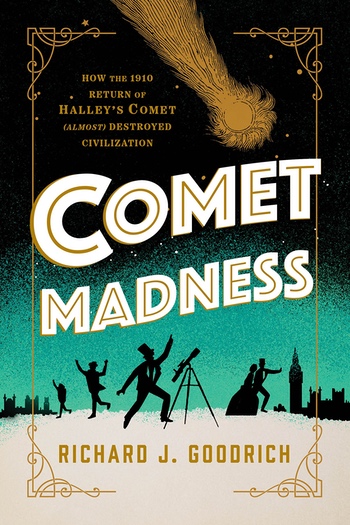Review: Comet Madnessby Jeff Foust
|
| The media is the primary villain in this account, mangling the truth about the comet and damaging the reputations of scientists. |
The coverage, for those outlets that engage in such stories, requires some level of creativity. A recent NPR story about 2023 DZ2 described the asteroid as “airplane-sized”, which is not particularly helpful: both an Airbus 380 and a Cessna 172 are airplanes, but the two are vastly different in size. By contrast, the Jerusalem Post is perhaps a little too specific: one recent story about a large, but non-threatening, asteroid described it as “the size of 69 American alligators”—definitely a non-metric unit of measurement. An earlier story by the same newspaper compared a meteor to a corgi, albeit one weighing as much as four baby elephants.
Such coverage—a mishmash of fear, wonder, and amusement—is not new. More than a century ago, Halley’s Comet passed through the inner solar system, with the promise of a spectacle in night skies as the comet came relatively close to the Earth. But the flyby came with it predictions of disaster and global apocalypse fanned by some newspapers, as Richard Goodrich describes in the new book Comet Madness.
Goodrich describes the 1910 flyby of Comet Halley largely through the lens of newspaper accounts, primarily in the United States. Initial stories about when the comet would be visible and how bright it might be gave way to concerns that the comet might collide with the Earth or that the Earth would pass through the tail of the comet. The latter led to predictions of mass conflagration or poisoning from cyanogen detected in the comet’s tail, even though that tail was extraordinarily tenuous.
Newspapers, he argued, played up those fears to sell papers. The media is the primary villain in this account, mangling the truth about the comet and damaging the reputations of scientists like French astronomer Camille Flammarion, whose studies of the comet were manipulated by the press to back their claims of impending doom. That effectively destroyed Flammarion’s reputation for a century.
| He highlights various incidents of hysteria, but quietly acknowledges they were isolated. “Despite the growing anxiety chronicled in the newspaper articles, a plurality of the world’s population anticipated the comet’s return with awe and amazement,” he writes. |
Worse, Goodrich offers evidence that the Associated Press, one of the leading news services then and now, made up some accounts of reactions to the comet. He describes one story of a person found in the California mountains attempting to nail himself to a tree ahead of the comet’s arrival—an attempt at self-crucifixion—that was widely distributed by the AP, yet never reported by the local newspaper. The same is true of another account, of a posse riding to the rescue of a woman in Oklahoma about to be sacrificed by a cult to the comet; it made the AP wires but not local papers.
(Goodrich’s disdain for the media’s conduct in 1910 may extend to 2023. “The best days of a reporter’s career are when something blows up, when disaster strikes, when people die or are threatened with death,” he writes in the present tense. Most contemporary reporters would argue that such disasters, natural or human-made, are among the biggest days of their careers, but not their best: covering such events is important and necessary, not desirable.)
The book’s subtitle suggests an account of a world on the verge of chaos because of the impending asteroid, yet when reading the book it’s clear that subtitle’s parenthetical is doing a lot of work. He highlights various incidents of hysteria that included, tragically, suicides, but quietly acknowledges they were isolated . “Despite the growing anxiety chronicled in the newspaper articles, a plurality of the world’s population anticipated the comet’s return with awe and amazement,” he writes. “For many, if not most humans, the comet was a marvel.” Perhaps the public ignored those sensationalist accounts of doom or dismissed them in favor more level-headed reporting; it is an issue that the author doesn’t pursue.
It's a strain of journalism that continues to this day, when some publications, particularly tabloids, breathlessly cover every approaching asteroid as if it is a threat to civilization; most readers apparently are not that concerned. (Few, if any, publications that reported the one-in-several-hundred impact risk posed by 2023 DW followed up on their coverage once additional observations ruled out any chance of a 2046 impact.) Even the Jerusalem Post, which measures asteroids in units of animal sizes, notes that the asteroid the size of 69 American alligators was no threat: “69 alligators, prowling around Florida, are likely a much more immediate danger, should you live in the area.” Whether they’re as dangerous as an extremely massive corgi, though, is unknown.
Note: we are using a new commenting system, which may require you to create a new account.
